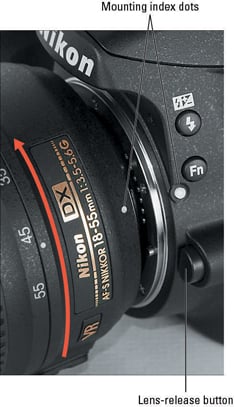Your Nikon D3200, like any dSLR camera, allows you to change lenses. Any many serious photographers want to own multiple lenses. This way, for example, you can mount a 50mm lens when you're taking portraits at close range and want a blurred background, or you can switch to a telephoto lens to shoot your child's baseball game from far away. An SLR lens also has a movable focusing ring that lets you focus manually instead of relying on the camera's autofocus mechanism.
How to attach a lens to your Nikon D3200
Your camera can autofocus only with a type of lens that carries the specification AF-S. (Well, technically speaking, the camera can autofocus with AF-I lenses also. But those are high-end, very expensive lenses that are no longer manufactured.) You can use other types of lenses, as long as they're compatible with your D3200's lens mount, but you have to focus manually and you may lose access to other camera functions as well. (See your camera manual for information about which functions aren't available with different types of non-AFS lenses.)
Whatever lens you choose, follow these steps to attach it to the camera body:
Turn the camera off and remove the cap that covers the lens mount on the front of the camera.
Remove the cap that covers the back of the lens.
Hold the lens in front of the camera so that the little white dot on the lens aligns with the matching dot on the camera body.
The technical term for those two little white dots is mounting index. But you get the point, and you can see the markings in question in the following figure.
 When attaching the lens, align the index markers as shown here.
When attaching the lens, align the index markers as shown here.Note that the figure shows the D3200 with its so-called kit lens — the 18-55mm AF-S Vibration Reduction (VR) zoom lens that Nikon sells as a unit with the camera body. If you buy a different lens, your lens mounting index may be some other color or shape, so check the lens instruction manual.
Keeping the dots aligned, as shown in the figure, position the lens on the camera's lens mount.
When you do so, grip the lens by its back collar (the part that doesn't move), not the movable, forward end of the lens barrel.
Turn the lens in a counterclockwise direction until the lens clicks into place.
In other words, turn the lens toward the side of the camera that sports the shutter button, as indicated by the red arrow in the preceding figure.
On a lens that has an aperture ring, set and lock the ring so the aperture is set at the highest f-stop number.
Check your lens manual to find out whether your lens sports an aperture ring and how to adjust it. (The D3200 kit lens doesn't.)
Even though the D3200 is equipped with a dust-reduction system, always attach (or switch) lenses in a clean environment to reduce the risk of getting dust, dirt, and other contaminants inside the camera or lens. Changing lenses on a beach, for example, isn't a good idea. For added safety, point the camera body slightly down when performing this maneuver; doing so helps prevent any flotsam in the air from being drawn into the camera by gravity.
How to remove a lens from your Nikon D3200
To detach a lens from the camera body, follow these steps:
Turn off the camera and then locate the lens-release button, labeled in the preceding figure.
Press the lens-release button while turning the lens clockwise (toward the button) until the mounting index on the lens is aligned with the index on the camera body.
In other words, line up the little white dots.
Place the rear protective cap onto the back of the lens.
If you aren't putting another lens on the camera, cover the lens mount with the protective cap that came with your camera, too.

